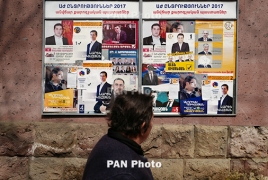
The Republican Party of Armenia (RPA) got 664,000 votes in 2012 and 769,000 votes in 2017 (+105,000 votes). Prosperous Armenia or Tsarukyan bloc received 455,000 votes in 2012 and 428,000 votes in 2017 (-27,000 votes).
The Armenian Revolutionary Federation Dashnaktsutyun (ARFD), which garnered 85,500 votes during the previous elections, got 103,000 in 2017 (+17500 votes), Orinats Yerkir or Armenian Renaissance party got 58,000 votes in 2017 against 83,000 votes in 2012 (-25000 votes).
Hertage party and the Armenian National Congress (ANC) received 87,000 and 107,000 respectively in 2012, gaining 194,000 votes altogether. However, things were different in 2017. While ANC united with the People's Party of Armenia (PPA), new players appeared at the political arena: Yelk (Wayout) bloc, Free Democrats and Oskanian-Raffi-Ohanyan (ORO) bloc, the latter’s key figure being not Raffi Hovannisian but former Defense Minister Seyran Ohanyan). The ANC-DPA, Yelk and Free Democrats gained 162,000 votes in general, which is 32,000 less than the opposition forces got in 2012. These very 32,000 went to the ORO bloc.
The votes received by the Communist Party decreased by 12,000.
In all, anti-governmental forces got less votes than during the previous elections, while the RPA and ARFD received 15.8% and 20.5% more votes respectively. As a result, the RPA garnered 49.15% of the votes in 2017 against 44.11% in 2012; ARFD got 6.58% of the votes against 5.68% in 2012.
Armenian Renaissance, ANC-DPA, Free Democrats, ORO and the Communists failed to make their way into the National Assembly.

